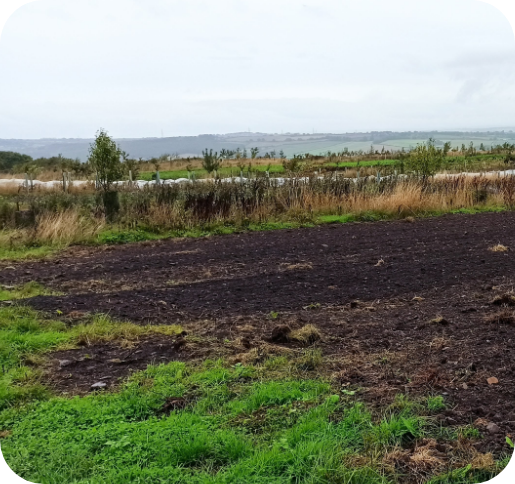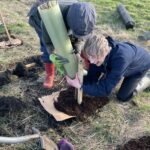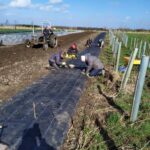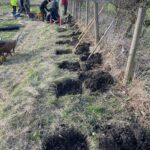

Contact person:
Rachel Putz
Director

LIVING LAB 7: United Kingdom
Gibside Community Farm
Community Supported Agriculture (CSA) farm
General information
Gibside CSA is located 30 minutes outside of Gateshead/ Newcastle upon Tyne in the north of England. The farm is a members co-op Community Interest Company (CIC) with two directors and a steering group of three others. There are about 20 members who come regularly to the field to grow the produce supported by contract growers for about 13 hours a week in the summer. Gibside Community Farm (GCF) rent a 5.8-hectare (ha) field from the National Trust. Many of the members have experience of growing in allotments but it is also a supportive place for people to come and learn about organic growing.
The National Trust were very supportive of the idea of a community farm being developed on their estate and helped the founder members in creating the CIC in 2013. In 2017, the lease on the land was granted and infrastructure could start to be placed on site. A 25-year farm business tenancy with Gibside National Trust estate was signed and the long lease time enabled the CSA to receive grants for buying trees. Agroforestry was part of the design at Gibside Community Farm from the beginning. The first grant they received was from the ‘MOREwoods‘ initiative by the Woodland Trust. However, they could only supply native trees, and the variety of species was limited. After approaching a local charitable trust, another £3000 was secured to purchase trees which suited the silvohorticulture system at GCF. The Agroforestry Research Trust‘s Martin Crawford gave advice.
One of the main reasons for incorporating trees into the CSA was to reduce the impact of wind on what is a very exposed site. The additional benefits of trees to the vegetable production and other beneficial relationships were also a consideration.
When initially setting up the silvohorticulture field, the members of GCF looked to the system at Wakelyns and Tolhurst Organic with a view to potentially replicating elements of what they were doing. Advice from Ian Tolhurst on the feasibility of the farm plan was also taken into consideration. Most of the trees in the alleys are immature at 5 years old. The shelterbelts are made up of young native trees, 7 to 8 years old, such as walnut, sweet chestnut, alder, birch, oak and scots pine.
Initially, the CSA was operating from the National Trust walled garden, to test the model before moving to the larger scale field they are currently in. Before the 5.8 ha field was converted to silvohorticulture, it was part of an arable rotation.
The vegetable produce is mainly sold through a bag scheme to members. It includes whatever is in season on the farm and is also sold via an online system. Other avenues of sales are through organic wholesale, a pop-up stall at the National Trust Gibside marketplace, and occasional markets. The yields in 2023 totalled 10.45 tonnes which included 5.5 tonnes of potatoes, 1.6 tonnes of alliums, 223 kg of beets, 2.22 tonnes of brassicas and 294 kg of legumes.
General farming approach
Organic
Objectives
As Gibside is a CSA farm, the main objective is to produce organic, seasonal and local vegetables for its members in an environmentally beneficial way through a bag scheme. Involving volunteers allows local people to be directly involved in the CSA whilst also making the project economically viable.
- The silvohorticulture agroforestry system helps provide shelter to the vegetable beds as the site is high and exposed so often has a lot of wind. There are also major shelterbelts around the perimeter of the farm for protection, which contains several rows of semi-mature native trees. The tree alleys create a microclimate which favours the vegetable production. An extra income source is also potentially created through the trees on the farm.
- The CSA has supported the local community by supplying gleaning (surplus vegetables and fruit) for the Waste Food Kitchen (Magic Hat Cafe).
Challenges
- Initially sourcing the trees through the Woodland Trust was a challenge as the varieties available were limited to native species and those that weren’t suitable for an agroforestry system. Gibside Community Farm approached a local charitable trust who gave a grant to source trees from an agroforestry specialist.
- Fitting the rotation in the field based on what other people had done and establishing the best alley width and length was a challenge – a good working length was needed for field scale.
- The main issue they are trying to overcome on the farm is how to minimise tillage in the vegetables. They hope to find an approach that doesn’t require expensive equipment and doing it by hand isn’t feasible due to the amount of time it takes. At the moment, they are reliant on flailing weeds.
- Finding enough vegetable bag customers so that money generated from them can become the main income stream is an ongoing challenge. They would like to strike a balance between the amount of produce that goes to organic wholesale and direct sales.
- F1 seeds have been used in the past, which has been limiting as they produce everything at the same time and this doesn’t suit the weekly vegetable bag model. In the future, they want to use open pollinated seeds at GCF so that produce is available steadily throughout the growing season and can be picked intermittently.
Research goals
The hope is to integrate more trees into the farm as there is still a wind issue on one side of the farm and because a couple of rows of agroforestry didn’t take and need to be replaced. GCF are interested to know more about additional tree species that could be planted in the spare alleys.
The economics of the CSA matter as it wouldn’t be able to continue without being financially viable. The agroforestry potentially creates an additional source of income for the farm and creates a microclimate that enables the vegetables to grow.
The team that run the site hope the REFOREST Living Lab will address the issue of reducing tillage in an organic system such as this and dealing with the resultant weeds. Currently they don’t have a solution that isn’t too expensive or time consuming but would welcome input on this from other farmers that are part of the living lab.
Design of the agroforestry system
In the 5.8 ha field of silvohorticulture there are 7 vegetable plots with 3 m-wide alleys of trees in-between. Each bed is 21 m by 100 m. The plots follow a 7-course rotation – a cycle of potatoes, brassicas, and alliums, followed by a 4-year rotation with long-term green manure. The plots were purposefully designed to be wide to minimise competition between trees and vegetables as well as making it possible to use field equipment. The trees in the alleys include basket willow, hazel, delicate fruit and tough fruit. The side of the field which does not have tree alleys has been used for grains and pulses but is now used as a hay field. There is also a market garden area with hedgerows between plots.
The major shelterbelts protecting the whole farm contain several rows of semi-mature native trees and will provide substantial protection from wind. The shelterbelts are across the southwest, west and northwest of the growing field. A windbreak to the northeast is also in situ by the entrance to the farm. A fruit orchard area is located to the north of the silvohorticulture beds, to the northwest of the field, with some protection from a hedge to the north. It currently consists of 44 apple trees, mainly half-standards on MM106 rootstock. The mixed varieties of fruit tree species growing in the orchard are valued as they have staggered harvesting times which ensures fruit is available for a longer period.
The farm applies horse manure to the vegetable beds from a local stable. There is a large polytunnel which is irrigated using overhead sprinklers. A large hay area is cut for around 33 silage bails each year by a contractor.
Monitoring
Standard soil data has been collected at the farm in the past, and extensive soil and land productivity data has recently been collected as part of the REFOREST project. This could be done again in the future to see if the soil has improved with the agroforestry system.
The site has a rain gauge but no weather station currently.
How to minimise tillage in the vegetable plots without using expensive equipment is a key issue. Finding out about ways in which people are doing this would make participating in the UK Living Lab particularly worthwhile.

England, UK

Fellside Rd, Burnopfield, Newcastle upon Tyne, NE16 5LA

Silvohorticulture, Orchards, Hedgerows, shelterbelts and riparian buffer strips

A range of vegetables including alliums, brassicas and potatoes

The field is rented from the National Trust and the official lease was granted 2017. Tree planting started in the winter of 2016 on the orchard, and in the winter of 2017 on the alley trees and shelterbelts.

Inter-row/In-row distance: 21 m x 100 m

Width of Tree Strips: 3m alleys - shelterbelt 5m

5.8 ha cultivated field
1.47 ha of vegetables
0.2 ha of alley trees

Horticulture

Livestock: No







